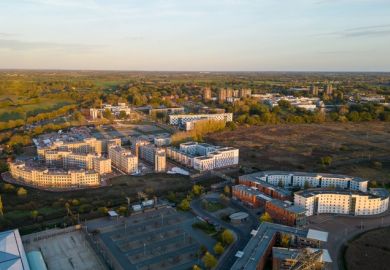Temporary employment rates in Swedish academia are more than double the national average, new research commissioned by the government has revealed.
According to an upcoming report by the Swedish Higher Education Authority (UKÄ), 32 per cent of Sweden’s research and teaching staff – a population of just under 40,000 – held fixed-term positions in 2022; across the labour market as a whole, meanwhile, less than 16 per cent were employed on a temporary basis. While the rates of temporary employment in universities have declined slightly since 2008, the study indicates, they have remained relatively steady for the past decade.
Fixed-term employment rates also vary depending on the institution and subject area, the study suggests. “The rate of permanent employment decreases as the level of externally funded research increases,” said author Elina Stengård, an analyst at UKÄ.
“Higher education institutions that are research-heavy generally have a higher rate of external funding and also a lower rate of permanent employment. Research-heavy academic fields will generally also have a lower rate of permanent employment.”
Of Sweden’s universities, Dr Stengård found, Chalmers University of Technology had the lowest rates of permanent employment in 2022, with 50 per cent of research and teaching staff holding temporary positions. In second place was the Stockholm School of Economics, followed by the Karolinska Institute, both of which employed less than 60 per cent of staff on a permanent basis.
Dr Stengård noted that some degree of temporary employment was “part of the established career path as a researcher”. For instance, she said, “the purpose of a postdoctoral fellowship is to enable the junior researcher to gain experience and extend their network. In other cases, the purpose of the temporary employment is to enable increased mobility between different higher education institutions.”
Sofia Lodén, associate professor at Stockholm University and chair of the Young Academy of Sweden, told Times Higher Education that although “mobility is very important for young scholars”, an excess of temporary positions could result in “stress and insecurity”.
“A researcher needs time to tackle big research questions,” she said. “If you have just a year, that’s not possible, because you’re always thinking of your next application.
“If you never have any sort of stability, you will not be able to develop as a scholar. The university has to have a system to identify talented researchers and give them the opportunity to develop.”
Speaking to Times Higher Education, Robert Andersson, head of negotiations at the Swedish Association of University Teachers and Researchers (SULF), said universities were “much too afraid to hire people on permanent contracts”.
“Insecure employments can affect health, but also general life,” he said. “For instance, you might not get a loan when you want to buy a house.” As a result, talented researchers might be dissuaded from pursuing an academic career, he added. “I do believe that many will leave academia for more secure and better-paid jobs elsewhere.”
Register to continue
Why register?
- Registration is free and only takes a moment
- Once registered, you can read 3 articles a month
- Sign up for our newsletter
Subscribe
Or subscribe for unlimited access to:
- Unlimited access to news, views, insights & reviews
- Digital editions
- Digital access to THE’s university and college rankings analysis
Already registered or a current subscriber?








